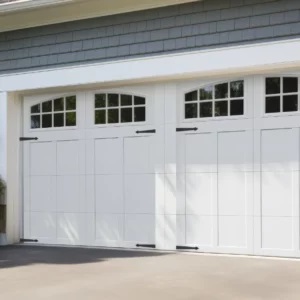
Contents
Picture this: you’re standing in your garage, admiring your sleek and sturdy garage door. But have you considered the safety measures that should be in place to protect you and your loved ones?
Installing garage door safety features is a crucial step in ensuring the security of your home and the well-being of those inside. In this discussion, we will guide you through the step-by-step process of installing these essential features, from assessing existing safety measures to troubleshooting any potential issues that may arise.
Get ready to take your garage door safety to the next level.
Key Takeaways to Garage Door Safety Features
- Regular maintenance and testing of garage door safety features are essential for their effectiveness.
- Installing safety features demonstrates responsible home ownership and ensures the security of your home and belongings.
- Selecting the right safety features, such as photoelectric sensors and auto-reverse mechanisms, can greatly reduce the risk of accidents and injuries.
- Hiring a professional garage door technician for thorough inspections and repairs ensures that all safety features are in optimal working condition.
Assessing Existing Safety Measures
To assess the safety measures currently in place, start by conducting a thorough inspection of your garage door system. This step is crucial to ensure that your garage door is functioning properly and is safe for you and your family.
Begin by visually inspecting the door itself. Look for any signs of wear and tear, such as frayed cables or loose hinges. Check the tracks to make sure they’re aligned and free from obstructions.
It’s also important to test the garage door opener. Press the wall-mounted button and listen for any unusual noises or grinding sounds.
Next, test the safety features of your garage door opener. Place a small object, like a roll of tape, in the path of the door and close it. The door should automatically reverse when it comes into contact with the object. If it doesn’t, you may need to adjust the sensitivity settings or replace the safety sensors.
Additionally, make sure that the emergency release cord is functioning properly. Pull the cord to disengage the opener and manually open and close the door. This will help you understand how the door operates in case of a power outage or emergency situation.
Selecting the Right Garage Door Safety Features
Ensure the safety of your garage door system by selecting the right safety features. When it comes to choosing the appropriate safety features for your garage door, there are several options to consider. By investing in these features, you can significantly reduce the risk of accidents and ensure the safety of your loved ones and belongings.
To help you make an informed decision, here is a table outlining some essential safety features and their benefits:
| Safety Feature | Benefits |
|---|---|
| Photoelectric Sensors | Detects objects or people in the path of the closing door, preventing it from closing and causing harm. |
| Auto-Reverse Mechanism | Automatically reverses the door if it comes into contact with an object or person, reducing the risk of injury. |
| Emergency Release Cord | Allows you to manually open the garage door in case of a power outage or malfunction. |
| Rolling Code Technology | Provides enhanced security by generating a unique access code each time the door is operated, preventing unauthorized entry. |
| Battery Backup System | Ensures that your garage door can still be opened and closed during power outages, keeping your belongings safe and accessible. |
By carefully selecting the right safety features for your garage door, you can create a secure and reliable system that gives you peace of mind. Remember, your garage door is not just a functional part of your home; it is an essential component that contributes to the overall safety and security of your property.
Investing in these safety features not only protects your loved ones and belongings but also demonstrates your commitment to creating a safe and welcoming environment. By prioritizing safety, you can enjoy your garage without worrying about potential accidents or intrusions.
Choose the right safety features for your garage door today and take control of your safety and security.
Gathering Necessary Tools and Equipment
Start by gathering all the necessary tools and equipment to install the safety features on your garage door. Having the right tools will ensure that the installation process goes smoothly and efficiently. Here are the essential items you’ll need:
- Power drill: This versatile tool will be used to drill holes and secure the safety features in place. Make sure it’s fully charged or has fresh batteries.
- Screwdriver: You’ll need both a flathead and a Phillips screwdriver to tighten screws and fasten components. Having a set of different sizes will come in handy.
- Measuring tape: Accurate measurements are crucial for a proper installation. Use a measuring tape to determine the correct placement of the safety features.
- Level: To ensure that the safety features are installed straight and level, a spirit or bubble level is essential. This tool will help you achieve a professional-looking result.
- Safety goggles and gloves: Protecting your eyes and hands is vital when working with tools and equipment. Wear safety goggles to shield your eyes from debris and gloves to prevent any injuries.
- Ladder or step stool: Depending on the height of your garage door, you may need a ladder or step stool to reach certain areas. Make sure it’s sturdy and secure before climbing it.
Installing Safety Sensors and Alarms
Now that you have gathered all the necessary tools and equipment, it’s time to move on to installing the safety sensors and alarms on your garage door. These safety features are essential for ensuring the well-being of your family and protecting your belongings. By installing sensors and alarms, you can enhance the security of your garage and prevent accidents or unauthorized access.
To help you understand the installation process better, let’s take a look at the following table that outlines the steps involved:
| Steps | Tools Required | Estimated Time |
|---|---|---|
| 1. Identify sensor location | Measuring tape, pencil | 10 minutes |
| 2. Mount sensors | Screwdriver, screws | 20 minutes |
| 3. Connect wiring | Wire stripper, wire nuts | 30 minutes |
Firstly, you need to identify the appropriate location for the sensors. Use a measuring tape to determine the ideal placement, and mark it with a pencil. Next, you will need to mount the sensors securely. Use a screwdriver and screws to attach them to the designated spots on the garage door.
Once the sensors are in place, it’s time to connect the wiring. A wire stripper is used to remove the insulation from the wires, and then wire nuts are used to connect the corresponding wires together. Make sure to follow the manufacturer’s instructions carefully to ensure proper connection.
After completing these steps, test the sensors and alarms to ensure they are functioning correctly. Open and close the garage door to check if the sensors detect any obstructions or unauthorized entry. If everything is working as expected, congratulations! You have successfully installed the safety sensors and alarms on your garage door.
Testing and Troubleshooting Garage Door Safety Features
To ensure the effectiveness of your garage door safety features, it’s important to test and troubleshoot them regularly. By doing so, you can have peace of mind knowing that your family and belongings are protected.
Here are some key steps to follow when testing and troubleshooting your garage door safety features:
- Perform a reverse test: Place a small block of wood on the ground where the garage door closes. Activate the door to close and observe if it reverses upon contact with the block. This test ensures that the door’s auto-reverse feature is working properly and can prevent accidents or injuries.
- Check the photoelectric sensors: These sensors are designed to detect any obstacles in the door’s path. To test them, simply wave a broom or long object in front of the sensors while the door is closing. If the sensors are functioning correctly, the door should stop and reverse its direction.
- Test the emergency release: This feature allows you to manually open the garage door in case of a power outage or malfunction. Pull the emergency release cord to disengage the door from the opener. Then, try lifting the door manually. If it moves smoothly and stays open, the emergency release is working properly.
Regularly testing and troubleshooting your garage door safety features not only ensures their effectiveness but also reinforces the sense of belonging and security within your home. By taking these simple steps, you can be confident that your garage door is equipped with reliable safety measures, providing a safe environment for your loved ones and belongings.
Summary
Now that you have successfully installed garage door safety features, you can rest easy knowing that your family and belongings are protected.
Remember, safety should always be a top priority. So, take the time to regularly test and troubleshoot these features to ensure they’re functioning properly.
With these precautions in place, you can confidently enjoy the convenience and peace of mind that a secure garage door brings.
Recent Posts
10 Best Steps for Replacing Your Garage Door Opener
Replacing your garage door opener is a task that can feel as intimidating as building
Unlocking Secrets: Mastering Overhead Door Installation
Did you know that nearly 70% of homeowners tackle overhead door installation themselves? This statistic
Top Tips for Installing Residential An Overhead Garage Door
Imagine you’re installing a new insulated steel overhead garage door to improve your home’s energy

